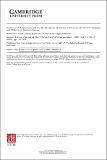| dc.description.abstract | Globally, the HIV/AIDS pandemic (UNICEF/UNAIDS 1999) has brought increased mortality for young adults, while many children have been orphaned and made vulnerable (Poonawala and Cantor 1991; Barnett and Blaikie 1992). A study carried out in Uganda confirms that the effects of HIV/AIDS usually spread beyond the households where parents or breadwinners die (Barnett and Blaikie 1992: 86-109). The increasing number of orphans also makes other children vulnerable because their share of available resources is reduced in households that accommodate orphans. In addition, some of these children are living with ailing widows, in most cases their surviving mothers, who are equally in need of support. An emergent problem is the lack of adequate support within the extended family network for those affected (see, for example, Ankrah 1993).
In Kenya, the number of young adult deaths due to HIV/AIDS was … | en_US |

